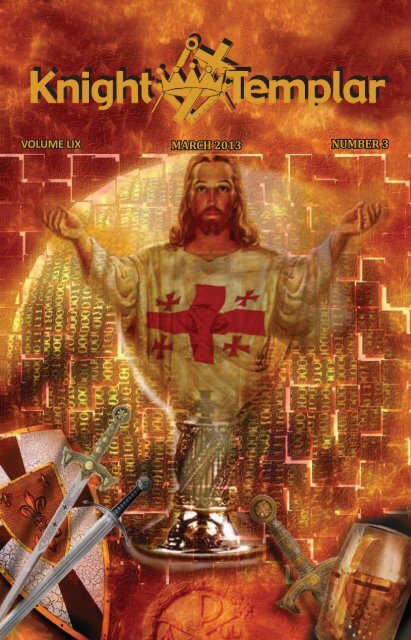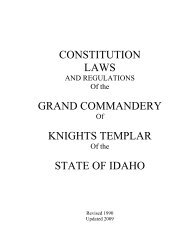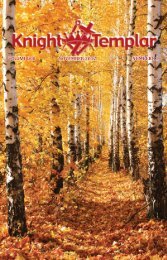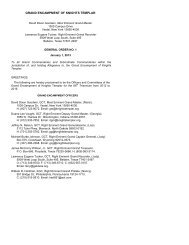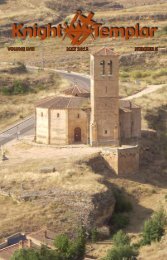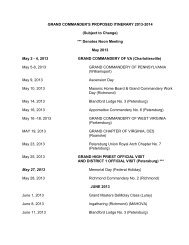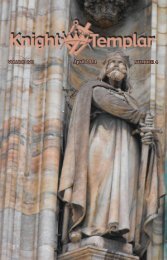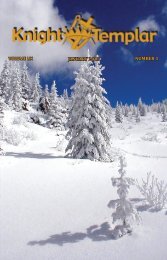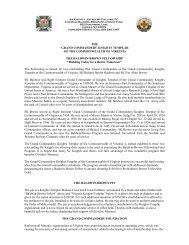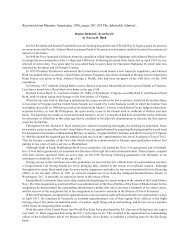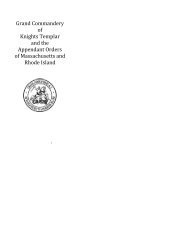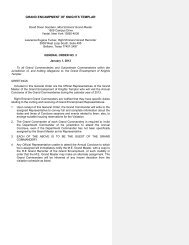march - Grand Encampment, Knights Templar
march - Grand Encampment, Knights Templar
march - Grand Encampment, Knights Templar
- No tags were found...
Create successful ePaper yourself
Turn your PDF publications into a flip-book with our unique Google optimized e-Paper software.
Contents<strong>Grand</strong> Master’s Message<strong>Grand</strong> Master David Dixon Goodwin................ 4Knight <strong>Templar</strong> Holy Land Pilgrimage............... 6Spring and God’s LoveReverend Sir Knight Donald C. Kerr.................. 7Brother Mel Blanc:“The Man of a Thousand Voices”Sir Knight Ivan Tribe......................................... 9An Encapsulated History of Cryptic Masonryin Europe and the United States Part 2Richard W. Van Doren.................................... 13Sir Knight Edward R. TrosinDepartment Commander forSubordinate Commanderies.......................... 24The World’s FreemasonrySir Knight Tom Jackson.................................. 25The Quarry ProjectSir Knight Bo Cline......................................... 32FeaturesVOLUME LIX MARCH 2013 NUMBER 3Published monthly as an official publication of the<strong>Grand</strong> <strong>Encampment</strong> of <strong>Knights</strong> <strong>Templar</strong>of the United States of America.David Dixon Goodwin<strong>Grand</strong> MasterJeffrey N. Nelson<strong>Grand</strong> Generalissimo and Publisher3112 Tyler ParkwayBismarck, ND 58503-0192Address changes or correctionsand all membership activityincluding deaths should be reportedto the Recorder of the localCommandery. Please do notreport them to the editor.JOHN L. PALMERManaging EditorPost Office Box 566Nolensville, TN 37135-0566Phone: (615) 283-8477Fax: (615) 283-8476E-mail: ktmagazine@comcast.netMagazine materials and correspondenceto the editor should be sent in electronicform to the managing editor whosecontact information is shown above.Materials and correspondence concerningthe <strong>Grand</strong> Commandery state supplementsshould be sent to the respectivesupplement editor.Lawrence E. TuckerPrelate’s Chapel ..........................................................5 <strong>Grand</strong> RecorderRecipients of the Membership Jewel..........................8<strong>Grand</strong> <strong>Encampment</strong> Office5909 West Loop South, Suite 495In Memoriam.............................................................15 Bellaire, TX 77401-2402The <strong>Knights</strong> <strong>Templar</strong> Eye Foundation..................16, 21 Phone: (713) 349-8700Letters to the Editor...................................................17Fax: (713) 349-8710E-mail: larry@gektusa.org<strong>Grand</strong> Commandery Supplement..............................18The cover artwork is by J. P. Noel andA Chat With The Managing Editor.............................22 used with his permission. J. P. NoelBeauceant News........................................................33is an author and a medieval digitalartist. See more about his work at<strong>Knights</strong> at the Bookshelf............................................34 www.theytrustednoone.com orwww.thestcroixark.com.<strong>Grand</strong> <strong>Encampment</strong> Web Site: http://www.knightstemplar.orgknight templar3
Prelate’sChapelbyRev. William D. Hartman, Right Eminent <strong>Grand</strong>Prelate of the <strong>Grand</strong> <strong>Encampment</strong>“Whenthe days drew near for him tobe received up, he set his face to goto Jerusalem.” Luke 9:51Jesus had told his disciples throughout his ministrythat he would eventually go to Jerusalemto be offered up as a sacrifice for the sins of theworld. Luke reminds us in his ninth chapter that the time came when Jesus firmlydecided to fulfill his ministry of redemption, but it was a journey filled with manythings. He did a lot of preaching along the way. He healed the sick, caused the lameto walk and the blind to see, dispelled all sorts of diseases, and even raised the deadback to life. In Jerusalem, he set about cleansing the temple, upsetting the leaders ofJudaism to the point that they wanted him killed. He would ride into Jerusalem on aSunday, hailed as King, and then be crucified that following Friday as a heretic and apolitical threat. He was buried in a borrowed tomb Friday night, no longer a threatto anyone, and soon to be forgotten. He had made the journey, and now it was over.In fact, from his cross he had uttered the words, “It is finished.”On Easter Sunday morning we will celebrate the victory of our Lord over sin anddeath. We will celebrate the end of that journey to Jerusalem as the beginning ofnew life for all who believe in our Lord and Savior Jesus Christ. The cross becomesour symbol, not of death but of hope for new life in God. The work Jesus came to doindeed was finished, for the debt of sin was paid by His death, and we are redeemedfrom our sentence of death to live forever with our God.What a message we have to share with a world that is over laden with sin anddeath. What a word of hope we can give to those who have given up all hope andare dead to life. As we journey through this life, we too can heal the sick at heart,we can help those walking lamely by the burdens they bear, we can cause the blindto see the light of Christ that will illuminate their journey through life. No matterhow hopeless this life may seem to others, we have the Word of Life to share withall those around us. When defeat threatens to overwhelm us, let “Thanks be to Godwho gives us the victory through our Lord Jesus Christ.” As Jesus set his face firmlyto go to Jerusalem to overcome death for us, “let us run with perseverance the racethat is set before us, looking to Jesus, the author and perfecter of our faith.”knight templar5
Dome of the Rock - Jerusalemcopyrighted by Joseph Calev.All Nations Church, Garden Of Gethsemane, Jerusalem6 copyrighted by Mordechai Meiri.<strong>march</strong> 2013
Spring and God’s LoveByReverend Sir Knight Donald C. KerrSpring is here or at least soon will be! The calendar says it is so, and we canalmost feel it. Springtime is a pleasant time. We feel the sense of beauty andenjoy nature. It is a time to re-set our lives in motion.This also is the month for two very important events. The one is Passover andthe other is Easter. Both in a way are celebrations of freedom. Passover is a remembranceof the Jewish exodus from Egypt. Easter is the reminder of the resurrectionof life. Each is an expression of rebirth, representing light emerging out ofdarkness. Each is an act of God. Who could conceive of such a power as God reachingout to touch the lives of people in some faraway exiled land to guide them to adestiny of resurrected life? The account is one of the most surprising love storiesin all literature.Love can be like that. It can search our hearts and follow our footsteps until it capturesour devotion. Love can come upon us in the most unsuspecting circumstancesto woo us into submission. That is what happened at Passover and Easter. God inall His infinite love entered into the soul of a man from Nazareth and into Israel sothat the human and divine became as one. Because of such a power, we hear abouta resurrection as if it were some transforming energy creating in life the power totouch eternity.How do we measure such love? Wecan’t. It is like a timeless river windingits way in ceaseless motion to reachits destiny. The love of God is endless,linking our fragmentary lives to thevast eternal resources of infinity.So may the remembrances ofthis hallowed time bring you joy, reassurance,and hope! So may it be.knight templarThe Reverend Sir Knight Donald C.Kerr, a member of Beauseant CommanderyNo. 8, Baltimore, MD, isPastor-emeritus of the Roland ParkPresbyterian Church in Baltimore.He resides at 700 John RinglingBoulevard, Apt. E202, Sarasota, FL34236-1586.7
Brother Mel Blanc:“The Man of a Thousand Voices”BySir Knight Ivan TribeAlthough the name of Mel Blancmay not be widely known, overthe last seventy-five years untoldmillions, especially children, haveheard his voice in one of its numerousforms. Virtually anyone who haswatched a Warner Brothers cartoon hasheard his voice as that of Bugs Bunny,Foghorn Leghorn, Porky Pig, and numerousother Warner characters. Blanc didnumerous other voices and sounds duringthe “Golden Age of Radio” and othercartoon voices as well. A lesser-knownfact concerning Blanc is his long affiliationwith the Order of DeMolay, bluelodge Masonry (fifty-eight years), theScottish Rite, and Shrine. Entertainingchildren at Shrine hospitals became oneof his principal causes in life.Melvin Jerome Blank (spelling of lastname later legally changed) was bornto a Jewish family in San Francisco, Californiaon May 30, 1908. The Blank family,which also included an older brother,Henry, soon moved to Portland, Oregonwhere Melvin grew to adulthood. Forthe most part, the youth proved to bean indifferent student, interested onlyin music and entertaining his friendswith voice imitations. Some faculty wereimpressed while others were not. Oneunappreciative teacher told him “you’llnever amount to anything” adding“you’re just like your last name, blank”;Mel legally changed it as soon as hecame of age. On the positive side, hejoined Sunnyside Chapter of DeMolayknight templarin 1925. He held the group in high esteemfor the rest of his life. In 1966, hereceived the Legion of Honor. On April27, 1987, Blanc was inducted into theirHall of Fame commenting at the time,“I have been a member of DeMolay forsixty-three years. I thank God and De-Molay for helping me become kind andthoughtful to my parents and all myfriends. I had many opportunities to dothe wrong things, and I might have donethem if it had not been for DeMolay.God bless them.”Intrigued by show business, Melvinwatched vaudeville performances wheneverhe could and also saw opportunitiesin the new medium of radio. StationKGW went on the air in 1922, and Blancwho dropped out of school prior tograduation, sang there with friends on aprogram called The Hoot Owls. Since localradio paid only a pittance, the youngdropout supported himself primarily asa tuba player. Initially interested in theviolin, he switched to the big horn becausethere were few tuba players andhe could get more work. After a coupleof years he returned to Portland as pitconductor at the Orpheum Theater.However, vaudeville was on the decline,and with the onset of the Great Depression,it went downhill at an acceleratedpace and eventually died.Mel did, however, scrape up enoughmoney to petition Mid Day Lodge No. 188in Portland. He received his Entered Apprenticedegree on November 20, 1930,9
and was passed a Fellowcraft on January5, 1931. Blanc was raised on March12, 1931. No one recalls whether he tookhis oral examination with different voices.Although he remained a faithful memberof Mid Day Lodge for fifty-eight years,Blanc had virtually no opportunity toserve as an officer because he left Portlandthat summer for California where helived most of his life thereafter.Mel figured that if he was goingto make it in show business, then hewould have to go to Hollywood. Onhis way southward he stopped for severalmonths in San Francisco where hetook a job as emcee and sometime joketeller in a variety program called TheRoad Show. Again, it did not pay much,but ethnically-diverse San Franciscoenabled him to develop and assimilatea wide variety of dialects. Hollywoodremained his ultimate goal where opportunitiesawaited in sound motionpictures, fledgling network radio, andperhaps musical work. Nonetheless,with the country mired in the GreatDepression and more job seekers thanpositions, Brother Blanc did not expectsuccess to come easily.Small speaking parts and soundson network radio programs becameBlanc’s principal forte, but he seldomcleared more than twenty-five dollars aweek in those early days. He did meethis future wife, Estelle Rosenbaum,whom he married in 1933. Some yearslater the couple had a son, Noel. Eventually,better and more regular partscame Mel’s way, but first he returnedto Portland for a time where he didmost of the male parts and wrote thescripts for a program called Cobwebsand Nuts. Estelle loaned her voice tothe show, portraying such girls as thecoquettish “Toots Waverly” and thesnooty “Mrs. McFlaggpoople IV.” Aftera time, Mel’s imagination wore thin andthe Blancs returned to Hollywood.Soon Brother Mel landed regular voiceparts on such network radio shows as JackBenny, George Burns & Gracie Allen, andJudy Canova. However, voices in animationart (or cartoons) really led to majorsuccess. In 1936, he became the voice ofWarner Brothers cartoon star, the stuttering“Porky Pig” although he was not theoriginal Porky. Later he added “Daffy Duck”and most notably “Bugs Bunny” who ultimatelybecame the biggest cartoon “star”in the studio’s animation departmentheadquartered in the old wooden buildingknown as “Termite Terrace.”As the decade of the forties ensued,Mel Blanc created additional voices tomatch new characters created by Warnerartists. Often the creations were antagonisticto each other: “Tweety” and“Sylvester,” “Henery Hawk” and “FoghornLeghorn” (my personal favorite). Bugs10 <strong>march</strong> 2013
Bunny, and Daffy Duck had two “human”rivals in “Yosemite Sam” and thehapless “Elmer Fudd” (the latter usuallyvoiced by Arthur Bryan). New creationsvoiced by Blanc that came along in thefifties included the French skunk “PepeLePew,” the Mexican mouse “SpeedyGonzales,” “Marvin the Martian,” andthe “Tasmanian Devil.” In addition, hevoiced many lesser figures in Warnercartoons and continued in network radioas long as the comedy dramas remainedon the networks. Before he hadan exclusive contract with Warner, duringthe decade of the 1950s, he voicedthe Walter Lantz creation “WoodyWoodpecker.” Although he gave up thisvoice, Lantz Productions continued todub in the distinctive laugh associatedwith Woody, a laugh Mel had originallycreated to irritate his high school principalmany years earlier.Outside of his voice workin cartoons, Mel Blanc hadsome other achievements.In the 1946-1947 season,he had a CBS network radioprogram, The Mel BlancShow, a sit-com in which hewas the hapless owner ofa fix-it shop. He had a pairof hit records “The WoodyWoodpecker Song” and“I Taut I Saw a Puddy Tat”based on Tweety and Sylvester. He alsovoiced numerous commercials rangingfrom the “Frito Bandito” to “Toucan Sam”in Fruit-Loop advertisements. After hisexclusive contract with Warner Brothersexpired in 1960, he continued to do voicework for them but did other cartoonvoices as well including “Barney Rubble”on The Flintstones, “Cosmo Spacely” onThe Jetsons, and the cat Heathcliff, theknight templarfirst two characters being products of theHanna-Barbera company.Brother Blanc continued Masonicrelated activity becoming a member ofthe Scottish Rite Valley of Los Angeles,taking his degrees from June 14 throughJune 16, 1951, giving his occupation as a“motion picture voice artist,” and Al MalaikahShrine Temple on June 29, 1951.Given his God-given talents, one mightcorrectly expect Noble Mel to be drawnto Shrine Hospital work. In his autobiographyhe wrote, “when I was teenager,I used to pass by the Portland ShrineHospital located not far from my parentshome. Hearing about the work they didwith crippled children was what initiallypiqued my interest in the fellowship andprompted me to seek admission.”Mel Blanc as a Shriner “spent countlesshours with the youngsters” adding“I don’t know who appreciateswhom more, me orthem. ‘Do Bugs Bunny! DoTweety! They . . .shout excitedly.’”Then on January24, 1961, the person RichLittle called “the greatestvoice man of all time” hada near brush with death.Brother Blanc’s car wasone-half of a head-on collisionon Sunset Boulevard.He sustained numerousbroken bones including thirty-nine fracturesin his right leg and a severe concussionand lost nine pints of blood. Forthree weeks he was in a coma. Blancfinally responded only when his physician,seeing a Warner Brothers cartoonon the TV asked, “How are you feelingtoday, Bugs Bunny?” Mel replied in hisbest known voice, that of the brash rabbit.“Eh, just fine Doc, how’re you.” He11
then replied to another question whenasked of Porky Pig, complete with stutter.He credited the two cartoon animalswith restoring his senses if not his life.After two more months in the hospitalduring which time he did some BarneyRubble sound tracks propped up in bed,he went home.Thankful that he had gotten his lifeback, Brother Mel began to do morecharity work. He wrote, “As soon asI was able to get around, I steppedup my number of appearances . . . atShrine hospitals.” Going to “the Los AngelesShrine Hospital for the first timesince my accident was very emotionalfor me,” he wrote. He explained why,“As I sat talking in Sylvester’s voice to adarling little girl, I thanked God for notrevoking this undeserved gift.”Although he walked with a cane forsome time, Mel Blanc’s voice was asstrong as ever. While Warner Brothersturned out fewer cartoons from 1960,Mel continued to voice them (until1969), and Hanna-Barbera TV programsprovided plenty of work. With son Noel,he founded Mel Blanc, Associates andturned out numerous advertisementssome of which proved quite lucrative. Inthe 1980s Warner’s produced some newanimated films and Mel’s familiar “what’sup Doc” was as strong as ever. However,he did let others do voices of those whoyelled loudly a great deal, such as YosemiteSam and Foghorn Leghorn.In 1988, Warner Books publishedBrother Blanc’s memoirs, That’s Not AllFolks. Among other things, he noted thathis voice totals were more like 850 ratherthan the thousand which public relationsreleases often claimed for him. Inthe volume he discussed his network radiodays, how cartoons were made, hisfriendships with such notables as JackBenny, his work with Shrine hospitals,and his close family. The memoir closeswith his eightieth birthday party, heldin 1988 at the Warner lot in Burbank,answering the question as to when heplanned to retire with the short reply,“the day I drop.”Unfortunately, that “day” came a littleover a year later. In early July, BrotherBlanc was hospitalized and fell out ofbed, breaking a femur. Complicationssoon set in causing a stroke; he died onJuly 10, 1989. A Warner animation artist,Darrell Van Citters, drew a memorableart work that featured a spotlight on amicrophone with Bugs Bunny, Daffy Duck,and seven other Warner cartoon characterswith their heads bowed in silence.Widely reprinted, it was appropriately titled“Speechless.” In addition to the moreconventional information, his tombstonecontains the famous sign-off on WarnerBrothers cartoons, “That’s All Folks.”Sir Knight Tribe, Ph.D. is a professoremeritus of history at the universityof Rio <strong>Grand</strong> in Ohio, and a holder ofthe KCT, KYCH, and 33 o . He has beena regular contributor to the Knight<strong>Templar</strong> magazine for many years andresides at 111 E. High Street, McArthur,OH 45651.Speechless12 <strong>march</strong> 2013
An Encapsulated Historyof Cryptic Masonry in Europeand the United StatesPart 2Continued from February 2013 issue.knight templarThe Stuart TheoryByRichard W. Van DorenThe known history of the Cryptic Ritebegins to emerge in the 18 th Century.Some have contended that it is Scottishin origin, having a definite connection tothe Stuart dynasty with the ritual havinga hidden meaning associated with BonniePrince Charlie and his attempts to restorethe crown to his family. For example,the “widow’s son” is tantamount to theheir of King Charles I who was executed;the “lost word” is related to be the “lostcause”; the “raising” of a Mason to referencethe restoration of the Stuart Crown.Further, the Stuart claim of origintheory relates that these “meanings” hadto be kept secret for the very reason thatthey were “treason” in the eyes of the currentmonarchy. That led to the need for“higher” degrees where the membershipcould be carefully and scrupulously maintainedwith a view to using the meetingplaces as planning sites and the doctrineof Stuart succession discreetly perpetuated.This, it is claimed, is the reason forthe legend of the “Secret Vault.”The Stuart claim for origin goes further:It maintains that the nine archesspecifically is a Stuart invention and alludesto their adaptation of the Legendof Enoch. According to Hinman, et al,“It appeared in two French degreescalled respectively, the “Scottish Masterof the Secret Vault of James VI” andthe “<strong>Grand</strong> Scottish Mason of the SacredVault of James VI.” The old Jewish andMasonic legends either have three arches,one under the other, or seven archeson a level. The candidate seeking admissionto the secret vault was called Adoniram,who in some of the degrees is themanufacturer of the Holy Vessels of theTemple and not Hiram Abif. As the taxgatherer of the Kings of Israel and Judah,he represented the Stuarts.”This is a wonderfully thought outtheory. Unfortunately, there is not oneshred of documentary proof that thetheory is correct. There is no questionthat the Stuarts in exile used the Masonichigher degrees originating in Francefor their own purposes, but to assertthat they also invented them is not crediblefrom what we know today.The Baltimore TheoryBaltimore was an important city,both commercially and Masonically inthe early 19 th Century. One of the theoriesof the origins of Cryptic Masonry13
then comes as no surprise to be linkedto Maryland. In 1810, the Select MasterDegree of Philip Eckel and HezekiahNiles had already been conferred at a“<strong>Grand</strong> Council” in Baltimore. JeremyCross, well known and widely traveledMasonic lecturer, received the degreefrom Eckel and spread it far and wide.So far, so good.But it gets more murky and tangledwhen one tries to include or connect theRoyal Master Degree with that of the SelectMaster. It is true that Eckel receivedthe Royal Master Degree in 1819 – nineyears after conferring the Select Masteron Cross, but that was conferred in aRoyal Arch Lodge. Folger has said thatit was actually Jeremy Cross who putthem together in either 1818 or 1823.It would seem that, if that were true, itwould be in the latter time frame as thatwas after he had inherited the Masonicpublishing mantle from Thomas SmithWebb in 1819. Those that still adhereto the Baltimore Theory, however, haveone troublesome detail that has cometo light. That stubborn fact is that wenow know that Eckels received the SelectMaster Degree from a man namedHenry Wilmans, a Past Master of a Lodgein Charleston, South Carolina (later tobe founding Master of a Lodge in Baltimore).Wilmans it seems was a ScottishRite Inspector General from Europe, andit was this power which permitted himto bestow the Select Master Degree onEckels in Baltimore in March of 1792.This leads us to the Scottish Rite Theory.Without going into a great deal of detailabout the origins of the Ancient andAccepted Scottish Rite (AASR), suffice itto say that it was founded in France andthat it emigrated to the United Statesby way of several individuals, the mostprominent being Stephen Morin, ca. 1761in the Caribbean and thence to Charleston,South Carolina, etc. Part of the earlyRite of Perfection (25 Degrees) was the5 th Degree, termed the “Knight of theEagle or Select Master.” Morin and hissuccessors, Francken (Charleston, 1762and Albany, New York 1767) and MosesHayes of Boston (1768) were early proponentsof not only the AASR but also of the“Cryptic Degrees.” According to Hinman,et al, shortly after the organization of theSupreme Council AASR in Charleston, in1802, they issued a manifesto outliningthe degrees to which they claimed jurisdiction.It stated:“Most of the Inspectors are in possessionof a number of detached degreesgiven in different parts of the world andwhich they generally communicate freeof expense to those brethren who arehigh enough to understand them suchas Select Mason of “27.” Such in briefis the Scottish Rite claim to the originand control over the Cryptic degrees. Itis supported by the fact that their members,some of whom were inspectors(e.g. Cohen, Jacobs, and Lownds), actuallydid confer the degrees and in everyinstance the first record of conferringof either the Royal Master or the SelectMaster Degrees indicates that it wasconferred by a member of the Rite ofPerfection.”So what happened that they arenot so associated today? According toHinman, it was because of a falling outwithin the ranks of the AASR, NorthernJurisdiction between J.J.J. Gourgas andJoseph Cerneau which saw that Lownds,most influential over both York Rite andthe Cryptic degrees, sided with Cer-14 <strong>march</strong> 2013
neau, and the Degrees were actuallypermanently exported into the YorkRite, ca. 1818.To be continued next monthDr. Richard W. Van Doren is a retired psychologistand Past Commander of Boston Commandery,No. 2 KT. He resides at 53 WintergreenLane, Groton, MA 01450-4220.Oscar David OlssonNew Jersey<strong>Grand</strong> Commander 1997Born: November 2, 1926Died: November 24, 2012Subscriptions to the Knight<strong>Templar</strong> magazine are availablefrom the <strong>Grand</strong> <strong>Encampment</strong> officeat a rate of $15.00 per year.Individual issues in quantitiesof less than 10 can be obtainedfor $1.50 each from the office ofthe managing editor if available.Inquire via e-mail to the managingeditor for quantities inexcess of 10. Some past issuesare archived on our web site.http://www.knightstemplar.org.We publish letters and articles from avariety of sources and points of view.The opinions expressed in these articlesdo not necessarily reflect theopinions or policy of the <strong>Grand</strong> <strong>Encampment</strong>,the Knight <strong>Templar</strong> magazine,or the Editorial Review Board.Charles D. KolbeWisconsin<strong>Grand</strong> Commander 2005Born: June 4, 1934Died: August 31, 2012Robert G. BirdMissouri<strong>Grand</strong> Commander 1984Born: May 31, 1923Died: November 22, 2012knight templarLeonard G. MathisonMinnesota<strong>Grand</strong> Commander 1984Born: August 23, 1913Died: December 22, 201215
<strong>Knights</strong> <strong>Templar</strong> Eye Foundation, Inc.1033 Long Prairie Road, Suite 5Flower Mound, TX 75022-4230Phone (214) 888-0220Fax (214) 888-0230.Greetings Sir <strong>Knights</strong>,What a wonderful time of year forbelievers, especially for each ofus as <strong>Knights</strong> <strong>Templar</strong>. Havingonly a few months ago celebrated thebirth of our Savior, we now begin the journeyto Golgotha where the price of salvationwas paid. In a few weeks, membersof <strong>Grand</strong> <strong>Encampment</strong> from all across ournation will be gathering to celebrate the resurrection of our Lord. From the WestCoast to the East Coast we shall proclaim, “He is risen from the dead.”My study today led me to the reading in scripture where we find our Lord in theGarden of Gethsemane. There, praying alone, our Lord said to the Father, “thy will bedone.” What an amazing four words, beyond at times our ability to truly comprehend.From this reading I was reminded that there are those in this world who facesorrow and suffering in their own lives. My prayer is that as <strong>Knights</strong> <strong>Templar</strong>, eachof us will determine not to walk away from suffering but will be Christ to those inneed of our help. My good friend and Past Commander, Sir Knight Mike Roberts, afew years ago in his Easter Message to our home Commandery challenged us to be“men of intent.” In other words, once having set our eyes upon the goal, we then seethe journey through.Another Sir Knight has often reminded us that it is not the titles or honors wehave heaped upon us in life that will be remembered, rather it will be what we didfor others that survives our meager existence. In the memories of our friends, families,and those we help will our true honor be found.In closing, consider the great work of the <strong>Knights</strong> <strong>Templar</strong> Eye Foundation. Thisfoundation exists today only because of each of the Sir <strong>Knights</strong> who make up ourCommanderies, large and small. Have we made a difference? Have we touched thelives of others? You bet we have! We have more to do, and I know we can. It is timefor us to be men of intent and see the journey though.God bless you Sir <strong>Knights</strong>; thank you for all you do. You make me PROUD!In His Service,Terry L. Plemons , KGC16 <strong>march</strong> 2013
Dear Sir Knight Palmer:Letters to the EditorI found the letter to the Editor fromSir Knight David Sheihan Hunter Lindezespecially interesting, and I am in totalagreement with his views.like the Christian <strong>Knights</strong> of old, we Christiansof today will stand up for our valuesand beliefs. If we would, our God and Creatorwill once again bless our land.Sincerely,In faith;Joseph F. RileyTerry W. SimontonPalestine Commandery No. 33Springfield, OhioCurrently living in Las Vegas, NevadaDear Sir Knight John Palmer,I would like to applaud Sir KnightDavid Sheihan Hunter Lindez of TrinityCommandery No 17 for the commentsmade in his letter to the editor in theJuly 2012 issue of the Knight <strong>Templar</strong>. Iagree wholeheartedly.During my lifetime, I have seen factionsslowly taking away the Christian referencesupon which our country was founded. Iam saddened that those factions are infiltratingthe Masonic fraternity.Removing Christian values from oursociety is the first step toward moral collapseof a country. Some examples areGermany in WWII, Iraq, Iran, Afghanistan,India, Egypt, and France.I have read that about 60% of ourcountry professes to be Christian. Thenwhy have we allowed prayer to be takenout of our schools, the Ten Commandmentsto be taken out of our public buildings,legalization of abortion, erosionof the institution of marriage, Christianworship in the military, taking Christ outof Christmas, and many other examples?I joined the Masonic fraternity becauseof its Christian values. I pray thatknight templarSir Knight John,My copy of the Knight <strong>Templar</strong> publicationcame in the mail last week. I hadan opportunity to sit down and read itfrom cover to cover in the last two days.Having finished the read, I happenedupon “<strong>Knights</strong> at the Bookshelf” on page34. The scathing review of a book on thepage, caused me to chuckle. It is a sorrycommentary on the sad state of oureducational system. All the “work” thatour Federal Government has performedin the area of education in our publicschools has been summed up in this article.The “No child left behind” attitudeand the change in scholastic achievementrequirements has produced graduatesthat do not have a basic educationand math foundation. Some graduatesdo not possess the mental ability to processsimple financial transactions withouta computer. They have problemsgiving the correct change in a simplepurchase at McDonald’s. I must say, Eng-Continued on Page 2017
General SupplementThe space on these two pages is provided by the Knight <strong>Templar</strong> magazineto be used by the <strong>Grand</strong> Commanderies to communicate with the individualSir <strong>Knights</strong> in their jurisdictions on a monthly basis. From timeto time and for various reasons, we fail to receive any material from theeditor of the state supplement for a given month. When this happens,we take the opportunity to offer you the information below. – The Ed.<strong>Grand</strong> Masters’Palace, Rhodes. Photo by editor.18 <strong>march</strong> 2013
Knight <strong>Templar</strong> Eye Foundation NewsAt the 92 nd Supreme Assembly held in Fort Worth, Texas this past September(Mrs. John A.) Mary Brogan, outgoing Supreme Worthy President, on behalfof all members of the Social Order of the Beauceant presented a check to<strong>Grand</strong> Master David Dixon Goodwin for the <strong>Knights</strong> <strong>Templar</strong> Eye Foundation, Inc.With this annual contribution, the total amount given to date by all Beauceant Assembliesacross the country has gone over three million dollars and these funds havegone a long way in supporting the Foundation in its charitable endeavors.2011-2012 Social Order of the Beauceant national officersFourteen Years of Continued Supportfor the <strong>Knights</strong> <strong>Templar</strong> Eye Foundation, Inc.<strong>Grand</strong> Master DavidGoodwin of the <strong>Grand</strong><strong>Encampment</strong> of theUnited States of Americapresents to Sir EdwardH. Fowler, Jr., the Provincial<strong>Grand</strong> Master of theProvincial <strong>Grand</strong> Lodgeof the Royal Order ofScotland of the UnitedStates of America, anappreciation certificatefrom the <strong>Knights</strong> <strong>Templar</strong>Eye Foundation, Inc. recognizingtheir continuedsupport for the Foundationunder his leadership.knight templar21
A Chat With The Managing EditorFor many years now at Christmas time, we have placed in our yard a crècheor nativity scene. We do this for two reasons; first, it makes a statementabout who we are and what we believe, and second, our neighbors likeit, or so we are told. It reminds them of the reason for the season. In recent years,including this one, neighborhood children have vandalized our display. As we wereconsidering whether it was worth all the effort to repair the display rather than simplydiscontinuing it, news arrived of the mass killing of children in Connecticut. Officialsimmediately began calling in armies of psychologists to determine what causedthis man to do this, the anti-gun people began to pound on their drums again, sometried to find someone to blame for inadequate security, and all began to discuss howto deter such actions in the future. During the next two days, two other individuals intwo other states were apprehended while planning similar copycat killings, one lessthan thirty miles from my home. On reflection, I have come to the conclusion thatthis reaction is much like a bunch of people trying to exterminate mice with flyswatterswhile ignoring the elephant in the dining room.You see, as an engineer, I am a great believer in cause and effect. I believe that itworks with people just as it does in science, but it is maybe a little more difficult todetect in human society. We seem to be focusing on deterrence in the short term.While this is probably necessary, we need also to be looking for root cause. When Iwas in elementary school, there was virtually no deterrence and virtually no massshooting of students. The problem is not a lack of deterrence, it is the existence ina person of a will to do such a thing. That is what has changed. It shouldn’t surpriseus that our civilization is deteriorating from civility to barbarism when we have deliberatelyundermined moral and family values. When Ward Cleaver and Andy Taylorhave been replaced by Homer Simpson and Alan Harper. When an unbelievable lackof responsibility has transitioned us from a ridiculous divorce rate to the presentwhen people just don’t see the need to get married, except for the homosexuals ofcourse. Why should this surprise us when on one hand we are actually paying peopleto have children out of wedlock and on the other hand encouraging the mass murderof innocent babies at government expense? Why should it surprise us when theproducts of this new society of ours decide to kill twenty innocent children only sixor seven years older than the ones whose killing we pay for every day?Cause and effect. If we keep on doing what we have been doing, we will keep ongetting what we have been getting. We have been very successful in erasing Godfrom our schools, from our government, from our public places, and sometimeseven from our churches. We have managed to reduce the Great Light of Masonryfrom the rule and guide of our faith and practice to an archaic book of outdated sillysuggestions as to how we might ought to conduct our lives and our society.Some of you will take offense at what I have had to say. That is your right. I be-22 <strong>march</strong> 2013
lieve it is also part of the cause of our current situation and certainly part of the effect.There is not much we can do as an organization to provide a deterrent to suchsenseless behavior. It is my prayer that the <strong>Knights</strong> of the Temple may be of use asindividuals in restoring a society where there is no longer a will to kill and destroy.We have our work cut out for us.Remember that my opinions are not necessarily those of the <strong>Grand</strong> <strong>Encampment</strong>,the <strong>Grand</strong> Officers, the Editorial Review Board, or the other 110,000 members. Ididn’t consult them. Since I don’t censor what you have to say when you write in, Idecided in this case to tell you what I really think.John L. PalmerManaging Editorknight templar23
knight templarThe World’s FreemasonryBySir Knight Tom JacksonEditors NoteThe article below was adapted from an address Brother Jackson made to the MasonicSociety during their annual meeting in 2012, was originally published in The Journal Of TheMasonic Society, Thomas W. Jackson, “The World’s Freemasonry,” Issue: 17 © The JournalOf The Masonic Society, and is used with permission.Ihave been afforded the great opportunityand privilege of being able to masonry’s philosophy would not be ap-how long this world may exist, that Free-travel over much of the world simply plicable to any society. It simply meansas a Freemason and to observe Freemasonryas it exists today. I therefore look change is no longer paramount in thesethat the need for dramatic societalat myself as a student of contemporary environments. In addition, a change inFreemasonry. Freemasonry is growing leadership style has reduced our philosophicalinfluence in some areas of themore rapidly than perhaps at any timein our history. There have been twentyfournew <strong>Grand</strong> Lodges consecrated ety. Where Freemasonry is now arising,world and made us less visible in soci-since the beginning of this century, and there exists the fertile fields to be cultivatedby those dedicated to a society inthere are others that will be consecratedin the not too distant future. The craft need of the gentle guidance of our craft.is emerging in Eastern Europe in countriesthat have either never had it or in tion of civil society for several hundredFreemasonry has impacted the evolu-countries in which it is been repressed years. It has changed significantly thefor decades. In Africa, with the general course of civilization. It has influenced theexception of the existence of Provincial development of some of the greatest menor District Lodges or <strong>Grand</strong> Lodges, Freemasonryis establishing roots in relative-purpose beyond any other, to continue towho have ever lived, and therein lies ourly untouched environments. What this contribute to the development of greatcan mean to the world is immeasurable. men. These great men will then influencethe ongoing evolution of civil soci-In many stable societies, however;the potential influence of Freemasonry ety. Make no doubt about it, my brothers,has become less than what it once was. were it not for Freemasonry, this worldThis is simply a matter of fact due to would be a vastly different place.those societies having evolved to a level I firmly believe that Freemasonry onof stability where future evolutionary the continent of Africa has probably thechange will be limited or at least slowed greatest potential beyond any other to impactits peoples, to contribute to the evo-in its development. This does not meanthat the need for the philosophical purposeof the craft has in any way become the future of this world. It has the opporlutionof its societies, and probably to alterlessened but its ongoing influence will tunity to show to the world what a philosophylike ours can contribute to mankind.be more subtle than in the past.There can never be a time, no matter It also, however, is perhaps going to25
meet some of the greatest challengesthat it has ever experienced, for it mustdeal not only with what might be one ofthe greatest diversities of societies, cultures,and religious beliefs located onone continent but must also deal withthe pressures which will be impressedby outside influences.My brothers, the philosophy of Freemasonryhas always and must alwaystranscend the variances with which itwill be confronted in the environment inwhich it exists. Because of the universalityof its purpose coupled with the constancyof its zeal, it has risen above thoserestrictive barriers that have hinderedsocietal evolution for several hundredyears. The very fact that it continues tothrive throughout the free world is undebatableevidence that its purpose isuniversal and undying.For most of our existence, eventhough there was that “Mystic Tie”binding us together in a universal brotherhood,there was a great tendency towarda provincial attitude of our <strong>Grand</strong>Lodges. We operated in a form of hierarchalisolationism. Today, however; moderntechnology has driven us to becomea more visible organization, forcing usaway from our isolationism and causingus to be more exposed and subject tomore external examination.What were once regarded as Masonic“secrets” can today be found by any computeror in any public library. This, however,in no way decreases our capacityof exerting our philosophical influenceon society. What it does mean is that wemust face reality, confront the complexitiesit brings with it, and adapt to usingthe technologies to further our goalswhich in turn must contribute to the bettermentof mankind. We first, however,must understand ourselves and our goals.I have traveled extensively throughoutthe world for the past two decadessimply for the cause of Freemasonry andhave been afforded the opportunity thatfew have had to study our present-daycraft and its methodologies of operation.I have been granted the privilege of meetingwith some great men and developingsome of the greatest friendships that onecould ever wish for. In doing so, I haveobserved the universality of the philosophicalpurpose of our craft regardlessof where it operates in the world. This Irefer to as its structural philosophy.I also, however, have become verycognizant of the differences that existin the operational philosophies ofFreemasonry. Where the structural philosophiesare an integral, inherent, andunchangeable characteristic of the craft,the operational philosophies seem to bemore driven by the characteristic of theenvironment in which it must operate.These operational variances are worthyof note, especially in areas where Freemasonryis in a developmental stage.From my studies and observations Ihave concluded that the personality ofFreemasonry in different parts of theworld is driven and shaped by the environmentin which it exists. This is truehistorically in most jurisdictions. Theonly exception that I have found was inearly Russian Freemasonry where thecraft tended to shape the society ratherthan the society shaping it.Based upon these operational variations,I have been attempting to categorizethe Freemasonry in different partsof the world in what I refer to as styles ofthe craft. Thus far, I have distinguished,at least for me, five distinctive styles, butI am sure that others, perhaps less dis-26 <strong>march</strong> 2013
tinctive, may exist or evolve into being.Please keep in mind that these styles aremy creation, and there could be thosewho disagree with me.When looking at Western EuropeanFreemasonry, we find that it retains moreof the basic philosophical and intellectualqualities that characterized Freemasonryfrom its inception. This would be an expectednatural phenomenon since itssurvival from the beginning has been dependentupon this style. External as wellas internal pressures, although excessiveat times and variable in their origins, dictatedan intellectual elitism dominated bysecrecy for its very survival. Thus, I haveclassified Western European Freemasonryas a philosophical style.The Freemasonry of the British Isles isclosely related to the philosophical styleof continental Europe. However, these<strong>Grand</strong> Lodges retained much more of thesocial atmosphere of their early beginnings,and I therefore place it into whatI refer to as a social style of Freemasonry.When Freemasonry migrated into theSouth and Central American countries, itretained much of the philosophical stylethat characterizes Western Europe. It didhowever change over the years by adoptinga more idealistic attitude of what itcan accomplish than is to be found anywhereelse in the world. The externalpressures of society with which it wasconfronted stimulated the creation of auniqueness in its Freemasonry that I referto as a sociological style. It is perhapsmore driven by the society in which it existsthan anywhere else in the world.Initially, I had included Mexican Freemasonryin a sociological style. However,it did not seem to fit comfortably in thiscategory. It has more of a tendency towarda political activism, and althoughknight templarI have many friends in Mexican Freemasonry,I frankly find it difficult to understand.For want of a more definitiveterm, I refer to Mexican Freemasonry asa political style of the craft.North American Freemasonry has divergedfurther away from its roots thanany Freemasonry in the world. Much ofthe intellectual elitism that contributedheavily to the creation of what mightarguably be referred to as the most influentialorganization ever conceived bythe mind of man has been sacrificed inthe pursuit of a static equality with asupport of charitable objectives. If anyexternal force is influencing Freemasonrytoday in America it’s our acceptanceof political correctness. Therefore I categorizethe Freemasonry in North Americaas a charitable style.Before I go farther let me clarify whatI mean by elitism as it impacts Freemasonryand intellectual elitism as it hasimpacted Freemasonry. My brothers,there is a tendency today for many tofrown upon elitism. I have found myselfat odds with some North American leadershipby the use of this term. Yet, theday that we said that our goal was totake GOOD men and make them better,we became elitist, and there is nothingwrong with that form of elitism. In addition,one of the greatest reasons webecame the major influential organizationthat we are, is because we attractedsome of the greatest minds that everlived, and that, my brothers, is intellectualelitism. Subtract that factor fromthe equation, and we are not nor couldwe have become what we are and were.Present day Eastern European Freemasonryhas not been in existence longenough to show whether it will retain thephilosophical style of its Western Euro-27
pean creators. A different mindset seemsto exist in these countries as a result offascist and communist suppression thatmight stimulate it to evolve into somethingdistinctive as a result of the differentsocietal pressures where it exists.Although I have spent some time inthe Far East, India, and the Philippinesas well as in Africa, I have not discerneda specific style which differentiates anddefines it. In these locations, as a resultof operating as Provincial or district<strong>Grand</strong> Lodges or Lodges for a prolongedperiod of time, there has been a tendencyto take on the characteristic ofthe mother <strong>Grand</strong> Lodge, but we shouldexpect a modification.If it is the intent of Freemasonry toremain a driving intellectual force in theevolution of civil society, if we wish forfuture historians to acknowledge ourcontributions in the developing worldfor the betterment of mankind, if wewant to continue toward our goal of takinggood men and making them better,then whatever style we choose mustlead us on a pathway to that end. Uponexamining the different styles that I havepresented to you, we can measure degreesof success in world Freemasonry.The philosophical style has been inexistence for the longest period of timeand has paved the way in almost everyother environment. Therefore differencesin style have all evolved from it. Ithas certainly stood the test of time andhas impacted the world in general, probablymore than any other. It was thisstyle that became an integral part of thecornerstone of the Enlightenment andit was the Enlightenment that served asa pathway out of the ignorance of thedark ages.The sociological style found in Centraland South America has not deviatedextensively from it. The infusion of theidealism has not in any way harmed thecraft’s potential in the society in which itlives. I am not convinced, however, that itcould thrive as well in other parts of theworld. The strength of this Freemasonryis a result of the continuing struggle tooperate within its environment. I havegreat respect for both the philosophicaland the sociological styles of the craft.As I have indicated earlier, I do notreally understand Mexican Freemasonry,but I do have a fear that it places itselfin jeopardy by coming close to violatinga basic Masonic protocol. Keep this inmind my brothers. We do not fear Freemasonsbecoming involved in politicalactivity, but we must never permit Freemasonryto become involved.I look at Canadian Freemasonry, althoughpart of North America, as a modifiedversion of both the philosophicaland charitable styles. They retain moreof the philosophical style from their originbut have been greatly influenced bythe charitable.Freemasonry in the United States,however, is purely a charitable style today.Interestingly, the change into thisstyle took place over the last 30 to 50years. It began its life as a philosophicalstyle as brought over by the earlysettlers from the British Isles and theEuropean continent. There can be nodoubt that its impact on the creationof the United States of America was extraordinary.The intellectual stimulus ofthe Enlightenment played a vital role inthe idealistic structuring of this country,and more than a few of the enlightenedthinkers who played a role in this structuringwere Freemasons.My brothers, it has changed. As a28 <strong>march</strong> 2013
ead; “let he who does not know, shutup and learn.”In addition to the damage that is beingcaused by our own membership onthe web, whose voice, because they areFreemasons, is accepted as fact by thenon-Mason as well as our own members,damage is caused by those who woulddestroy us. Our enemies have found fertileground on the web to dissipate theirvitriolic hate of our fraternity. This wecannot contain any more than we couldcontain it in the past, but we must understandthat it is there and educate ourmembership concerning it.We have been fortunate to have beenable to carry our isolationist attitude intoalmost the present day, but my brothers,like it or not, it is over. This modern technologyalong with the present-day attitudeof our leadership is removing thatchoice from us.One of our glaring weaknesses asleaders today has been our inability tosee the big picture of the craft. We havea tendency to lose sight of the great accomplishmentsfor which Freemasonryhas been known and to concentrate ourefforts on issues not paramount to ourexistence and of little consequence tosociety. This is not a viable option. Wesimply cannot afford to fail to understandthe diverse impacts that we have createdand continue to create on human society.For 300 years, our past brothersworked to develop an unparalleled organizationwhose philosophical purposecould easily be used as a template forworld peace, and there has probablybeen no time in our existence that the influenceof that philosophy was anymoreneeded in the world than it is today.As we acknowledge and recognizeour place in the world as Freemasons,knight templarwe must also acknowledge and recognizeour responsibility to the world asFreemasons. Our brothers of the pasthave done their job exceedingly well.They have placed the Fraternity in theforefront as an elite organization, onehighly respected for its contribution indeveloping world society. It is now up tous to continue to build upon what theyestablished. The very least we must doas Freemasons to contribute to a betterworld is to live as Freemasons, and somote it ever be.Sir Knight Jackson is a Past Commander ofContinental Commandery No. 56 in Chambersburg,Pennsylvania. Tom served fortwenty years as the Right Worshipful <strong>Grand</strong>Secretary of Pennsylvania and now servesas the Executive Secretary of the WorldConference of Masonic <strong>Grand</strong> Lodges havingserved in this position since its inceptionin 1998. He is a Past Division Commander ofthe <strong>Grand</strong> Commandery of <strong>Knights</strong> <strong>Templar</strong>of Pennsylvania and a Knight Commanderof the Temple of the <strong>Grand</strong> <strong>Encampment</strong>.He resides at 210 Middlespring Rd., Shippensburg,PA 17257, and his e-mail addressis twjcowboy@aol.com.31
Initiatives like the International Conferenceon the History of Freemasonry,the Worldwide Exemplification of Freemasonry,and UCLA’s “Freemasonry and CivilSociety” demonstrate an ever growing interestfrom the academic community in the historyand philosophy of our great fraternity. Itis gratifying to witness this increased attentionfrom the non-Masonic community, and it presentsa challenge for us as Masons to providea balanced view of the fraternity from thosewho have experienced Masonry from withinour fair Craft. The most significant aspect ofthis challenge is that few Masons hold the same level of knowledge and abilities asthose in the academic community. To help rectify this discrepancy, The Masonic Society(www.themasonicsociety.com) and the Masonic Library and Museum Association(http://www.masoniclibraries.org) have joined forces to establish The Quarry Project.Phase one of this endeavor will be the Conference on Masonic Research and Preservationto be held at the George Washington Masonic Memorial in Alexandria, Virginiaon September 27-29, 2013. The conference is open to anyone interested in Masonicresearch and preservation but will be specifically targeted toward two groups: membersof Masonic Lodges of research as well as authors, writers, and researchers (bothpublished and aspiring) and Masonic librarians and museum curators.The conference will draw from both the Masonic and academic communities toprovide detailed instruction on Masonic research and the editing of same. In addition,the recommendations of a committee created to establish a set of voluntarystandards for future Masonic research, writing, and editing will be introduced. Professionallibrarians, museum curators, and experts on displayand preservation will address that area of interest. Multipleconcurrent presentations on both fields of endeavor will be offeredon all three days. Along the way, participants will be enthusedand inspired by stories from successful Masonic libraryand museum curators and from published Masonic authors.Program details and conference registration for this event,along with hotel reservation information, is now available atwww.thequarryproject.com. Make your arrangements todayto join us in Alexandria, Virginia.John R. “Bo” Cline, President, The Masonic Society32 <strong>march</strong> 2013
Past Supreme Worthy Presidents photographed at Supreme Assembly held in<strong>Grand</strong> Rapids, Michigan in 1941. Photo given to Mrs. Joe Cortez, Supreme WorthyPresident, by (Mrs. Kai) Joan Kofoed, Recorder of <strong>Grand</strong> Rapids Assembly No. 68.Past Supreme Worthy Presidents photographed at Supreme Assembly in Ft. Worth,Texas in 2012. Seated left to right: Mrs. Paul E. Case (1979-1980), Mrs. WilliamChant (1992-1993), Mrs. Keith W. Dean (1993-1994), Mrs. Harry S. Rogers (1994-1995), Mrs. Howard L. McClure (1995-1996), Mrs. Milton F. Baker (1996-1997),Mrs. Esther K. Offen (1998-1999). Standing left to right: Mrs. Jay U. Ipsen (1999-2000), Mrs. Fred H. Buxton (2001-2002), Mrs. R. D. Moore (2002-2003), Mrs. JackL. Edwards (2005-2006), Mrs. David E. Alcon (2006-2007), Mrs. Richard B. Cotton(2007-2008), Mrs. John Kleinfelder (2008-2009), Mrs. W. Joe Ryland (2010-2011).Photo provided by Sir Knight John Kleinfelder.knight templar33
<strong>Knights</strong>at the BookshelfBySir Knight John L. PalmerThe Liverpool Masonic Rebellion and the Wigan <strong>Grand</strong> Lodge by Dr. David Harrison,Ph.D. Published 2012 by Arima. ISBN: 978-1-84549-567-9.The <strong>Grand</strong> Lodge system which has served Freemasonry so well for the past200 years seems to many of us to have been the norm from time immemorial.Information about the period from the first <strong>Grand</strong> Lodge in 1717 untilthe unification of the United <strong>Grand</strong> Lodge of England in 1813 has been well studiedand widely disseminated. Dr. Harrison in his new book reveals that the strife of transitionto centralized authority did not indeed end in 1813. His detailed account ofhow resistance to centralized authority continued well after the unification is bothfascinating and educational.The author points out that there were several Masonic “rebellions” against the United<strong>Grand</strong> Lodge after the dispute withthe Ancients was settled and goes intodetail about the lodges and personalitiesinvolved. Some of the behavior hedescribes unfortunately reminds us ofsome things we see today. He relatesthe Masonic unrest to the societalsituation in that part of England at thetime and points out that non-Masoniccircumstances can sometimes shapethe attitudes of the brethren whendealing within the lodge.As usual, Dr. Harrison unfolds inminute detail the characters andevents involved in the rebellion. Irecommend this book to anyone interestedin the transitions the crafthas been through and what theselessons may hold for the future, as hewho ignores history is often doomedto repeat it.34 <strong>march</strong> 2013
.knight templarknight templarTO ORDERCall toll-free at 1-800-426-5225 or35visit www.lighthouseuniform.com 535
Knight <strong>Templar</strong>5909 West Loop South, Suite 495Bellaire, TX 77401-2402…This cup is the newtestament in my blood,which is shed for you.Luke 22:20


